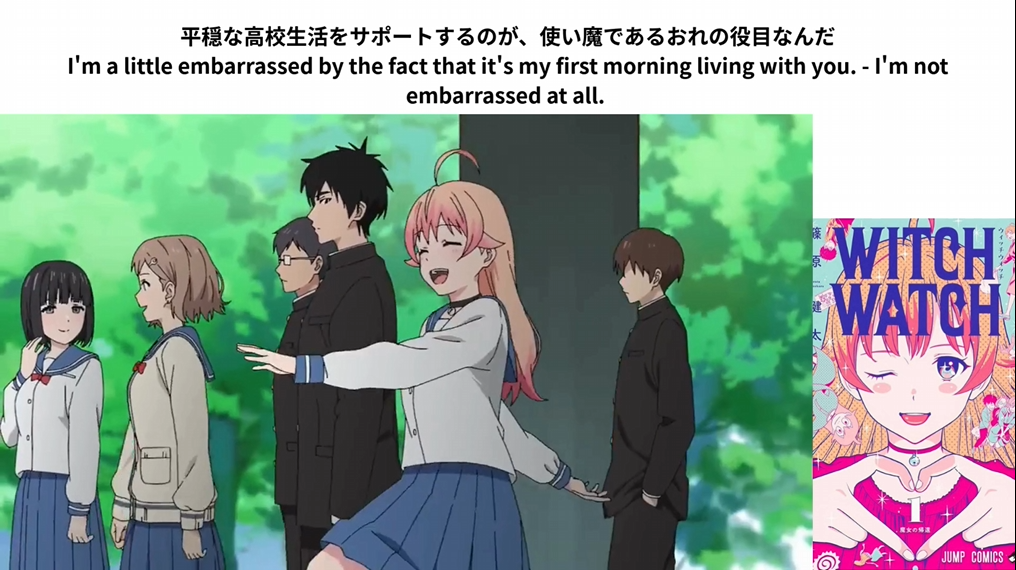Today's lesson is vocabulary and grammar explanation. After giving basic level vocabulary and advanced level vocabulary, I will give you a brief grammar explanation.
Standard Level Vocabulary ~1:00
Click on a word to open the dictionary.
| vocabulary | hiragana | pronunciation | meaning | POS |
|---|---|---|---|---|
| じゃあ | じゃあ | jaa | well then, so | interjection |
| スタート | すたーと | sutaato | start | noun / する-verb (loanword) |
| 見る | みる | miru | to see, to look | verb (ichidan) |
| 高校 | こうこう | koukou | high school | noun |
| 生活 | せいかつ | seikatsu | life, daily living | noun / する-verb |
| 初めて | はじめて | hajimete | for the first time | adverb |
| 朝 | あさ | asa | morning | noun |
| 軽い | かるい | karui | light (not heavy) | i-adjective |
| 言う | いう | iu | to say | verb (godan) |
| 二人 | ふたり | futari | two people | noun |
| 立つ | たつ | tatsu | to stand | verb (godan) |
| 次 | つぎ | tsugi | next | noun |
| 気持ち | きもち | kimochi | feeling | noun |
| はい | はい | hai | yes | interjection |
Advanced Level Vocabulary ~1:00
Click on a word to open the dictionary.
| vocabulary | hiragana | pronunciation | meaning | POS |
|---|---|---|---|---|
| とりあえず | とりあえず | toriaezu | for now; first of all | adverb |
| 見違える | みちがえる | michigaeru | to hardly recognize (someone/something) | verb (ichidan) |
| 平穏 | へいおん | heion | calm, tranquility | noun / na-adjective |
| サポート | さぽーと | sapooto | support | noun / する-verb (loanword) |
| 役目 | やくめ | yakume | role, duty | noun |
| 照れる | てれる | tereru | to feel embarrassed/shy | verb (ichidan) |
| 別に | べつに | betsu ni | not particularly, not really | adverb |
| 世の中 | よのなか | yo no naka | the world, society | noun |
| 完全 | かんぜん | kanzen | perfect, complete | noun / na-adjective |
| 魔法 | まほう | mahou | magic | noun |
| 便利 | べんり | benri | convenient | na-adjective |
| 救う | すくう | sukuu | to save, to rescue | verb (godan) |
Grammar Explanation
Study the important grammar in the video!
1. ~なんだ

Meaning: Oh, I see / It turns out that...
Explanation:
「~なんだ」 is a spoken form used to express realization, explanation, or discovery. It’s made of 「~のだ」 in casual speech.
It helps give a reason, explain a situation, or express understanding.
Structure:
[Plain form] + んだ / なんだ
(「なんだ」 is used after nouns and な-adjectives.)
Examples:
彼は先生なんだ。
Oh, he’s a teacher.
そういうことなんだね。
Ah, so that’s what it is.
Note:
- 「なんだ」 is casual and often shows a small emotional reaction or realization.
- It’s a combination of explanatory 「の」 + 「だ」. When attaching to nouns/na-adjectives, it becomes 「なんだ」.
2. すれば (Conditional form)

Meaning: If [do] / When [do]
Explanation:
「すれば」 is the conditional form of the verb 「する」 (to do). It expresses "if you do (something), then..."
Structure:
Verb (する) → すれば
Other verbs:
- Group 1: 書く → 書けば
- Group 2: 食べる → 食べれば
Examples:
勉強すれば、上手になります。
If you study, you’ll get better.
もっと早く来れば、会えたのに。
If you had come earlier, we could have met.
Note:
- This form shows condition. It’s often used with advice, results, or regrets.
- It’s more formal than casual forms like 「したら」.
3. ~くらい / ~くらいには (Degree / Approximation)

Meaning: About / To the extent that...
Explanation:
「くらい」 is used to show amount, degree, or comparison. It can mean “about (amount)” or “as much as / to the extent that…”.
Examples:
毎日1時間くらい日本語を勉強します。
I study Japanese for about 1 hour every day.
泣きたいくらいうれしかった。
I was so happy I could cry.
朝ごはんを食べるくらいには起きてください。
Please wake up at least enough to eat breakfast.
Note:
- 「くらい」 and 「ぐらい」 are the same. 「ぐらい」 is softer in sound.
- 「くらいには」 is used when comparing to a minimum level or time.